|
|
|
Bolex Paillard - Model D8L 1959
Made by Paillard Ltd., Sainte-Croix, Switzerland.
Highly polished duraluminium body, covered in Marocco leather. Metal parts chrome plated.
The camera features:
Lens:
- Triple turret with three standard D mount lenses. All lenses made by Kern Paillard Switzerland, model Yvar: 1:2,8 f=12,5 mm AR No 231659; 1:1,8 f=13 mm AR No 673107; 1:2,8 f=36 mm AR No 223399 (telephoto lens);
- Film footage counter - on the back of the camera. The film being loaded, the letters ‘ft’ will appear behind the window, the indicator automatically returns to the starting point when the pressure pad lever is operated. Audible end of film signal. Reset to zero upon reloading:
- Double run 8 mm film on 25 ft spools; the film will be running twice, one half of the film being exposed each time; The sensitivity is expressed in ASA, DIN and Scheiner;
- Film speed: 12,16,18,24,32,48,64 fps;
- Continuous running, normal running, single frame exposure;
- parallax compensating viewfinder; the viewfinder is continuously adjustable to match the field covered by lens of 12,5 (standard) to 36 mm (telephoto) focal length (setting knob- top corner- in the Pict); on the Kern Paillard lenses, a red number indicates the distance most frequently used;
- Variable shutter;
- Exposure meter: A photoelectric selenium cell measure light trough the lens. Two needle indicators in the viewfinder are then aligned by adjusting diaphragm on the lens. The diaphragm is built-in lightmeter with photoelectric cell. The lightmeter includes: - a photoelectric selenium cell; - a highly sensitive galvanometer (in the Pict. over the lens);
- Tripod socket - English (1/4” thread).
- The original leather Bolex case - produced in England.
The serial production number: No 783940
|
|
|
|
|
|
|
|
|
|
Bolex Paillard - Model Zoom Reflex P3 1963
Made by Paillard Ltd., Sainte-Croix, Switzerland.
Highly polished duraluminium body, covered in Marocco leather. Metal parts chrome plated.
The features:
Many features are the same as on Model D8L:
- Film speed; Film footage counter; Double run 8 mm film on 25 ft spools; The same features of filming; Control of variable shutter; reflex viewfinder
New features:
- Lens: SOM Berthiot Pan-Cinor 1:1,9 f=8-40 mm; made in France;
This zoom lens lets to select any focal length from that of a wide angle lens (8 mm) to that of a telephoto lens (25 mm to 40 mm) including the intermediate focal length of a standard lens (13 mm ). The vary the focal length can be adjusted with the power zoom control or by the manual zoom (visible in the pictures - black long lever).
On the lens tube are adjustments:
1. Focusing ring for distances of 3 1/2 ft to infinity (red figures for feet, white for meters); 2. Focal length scale; 3. Manual zoom lever; 4. Diaphragm ring graduated from f/1.9 to f/16; 5. Battery retaining cap (power zoom); 6. Control lever for varying focal length from wide angle to telephoto; 7. Control lever for varying focal length from telephoto to wide angle (visible in the picture - two black long buttons with wide horizontal straps).
The zoom motor is powered by two batteries: Mallory Type ZM-1 or RM-1;
- The sensitivity is expressed in ASA only;
- Manual rewind by hand crank (in our collection);
-Exposure meter is operating by battery - Mallory PX 450;
- Tripod socket - English (1/4” thread).
- The original leather Bolex case.
Serial production number: No A 24156
Amateur Cine Word magazine - 16 April, 1963 announced the camera: “The P3 is a very advanced camera. Its coincident image rangefinding is unique: the double image, brought into superimposition when the camera is focused, extends right over the field of view. Never has pin sharp focussing been so simple to achieve.”
|
|
|
|
|
|
|
|
|
|
Bolex Paillard - Model B 8 -1956 (according to production No)
Made by Paillard Ltd., Sainte-Croix, Switzerland.
Highly polished duraluminium body, covered in Marocco leather. Metal parts chrome plated.
The features:
Lens:
- Double turret; accommodates two standard D mount lenses: SOM Berthiot Cinor B, No F47994 1:1.9 f=12,5 mm; No F60361 1:2 f=35 mm
- Double run 8 mm film on 25 ft spools; the film will be running twice, one half of the film being exposed each time;
- Film speed: 12,16,18,24,32,48,64 fps;
- Release button: continuous exposures can be made by a sliding release lever (on the edge of the camera) or cable release;
- Viewfinder - optical;
- Tripod socket - English (1/4” thread).
Accessories
- parallax corrector prism for correction parallax error when framing close-ups with the focus mount Yvar 12.5 mm lens (in the picture small box with two square prisms). Two prism slid into place over the viewfinder;
- bifocal lens - eye site correction lens for viewfinder;
- two sunshades;
- filter;
- automatic selftimer - the timer can be adjusted to film a scene from 5 to 20 seconds in length. It fits into the cable release socket.

Made by Bolex Paillard, Switzerland.
Serial production number: No 563317
|
|
|
|
|
|
|
|
|
|
Bolex Paillard - Model C 8 -1958 (according to production No)
Made by Paillard Ltd., Sainte-Croix, Switzerland.
Highly polished duraluminium body, covered in Marocco leather. Metal parts chrome plated.
The features are manly same as model B 8:
- Lens: made by Kern Paillard Switzerland, model Yvar: 1:1,9 f=13 mm AR No 412002; it is only difference between model B 8 and C 8 - the lens is single.
- Double run 8 mm film on 25 ft spools; the film will be running twice, one half of the film being exposed each time;
- Film speed: 12,16,18,24,32,48,64 fps;
- Release button: continuous exposures can be made by a sliding release lever (on the edge of the camera) or cable release;
- Viewfinder - optical;
- Tripod socket - English (1/4” thread).
Serial production number: No 696187
|
|
|
|
|
|
|
|
|
|
Bolex Model 581 Sound Macrozoom ca 1976
The camera and lens made in Japan by Japanese Chinon Corporation for Bolex International S.A. Yverdon, Switzerland.
The camera takes super 8 mm cassette - 50 ft (15 meters).
The features:
- Motor Power from 6 - Alkaline manganese batteries of 1,5 V. It supplies power to: the motor, power zoom and light meter. The batteries are fitted in batteries holder in the pistol grip;
- Lens: Bolex Macrozoom 1:1,7 f=7,5 - 60 mm; Lens with macro manual and variable speed power zoom; macro focusing
- Film speed: 18 and 36 fps and single frame;
- On the top of the camera is a rocker switch to operate power zoom (Pict. ‘Top’ - letters D - V);
- Film counter with adjustable scale, indicated in foot and meters;
- ND (Neutral Density) filter - adjustment of light by sliding the button in left top corner (Pict. ‘left side’);
- If a series of scenes must to be shot under artificial light a special key must be inserted into slot on top of the camera, so that the filter is removed;
- The key is stored under the battery pack, in the bottom of the hand grip;
- Auto or manual recording level control;
- The original camera case.
All mechanism are working very well.
Accessories:
- Key filter;
- Microphone
Serial production number: No 109043 |
|
Right side of the camera
Left side of the camera
Microphone |
|
|
|
|
|
|
|
Eumig Model C4 -1937 Made in Austria
Made by Eumig, Vienna X, Austria, Buchengasse 11- 15.
Eumig was an Austrian manufacturer of radios (“Eumig Baby”), movie cameras and projectors, cartridge deck, etc. The company existed from 1919. The “Eumig” name was formed from the initial letters of the Company name - "Elektrizitäts und Metallwaren Industrie Gesellschaft," ("Electricity and Metalware Industry Company").
In 1928 the Company begun a development of film devices. The first movie camera ‘Eumig C1’ for 9,5 mm was introduced in 1932 and in 1935 second model ‘Eumig C2’. In 1937, models - Eumig C3 and C4, for 8 mm films, appeared on the market.
The camera Eumig C4 with drive by electric motor. The camera was the first 8 mm amateur movie camera in the world with electric power.
The camera features:
Construction and finish: The body of the camera is made of aluminium alloy metal with black crystalline finished. The paint is partly worn at the edges. The plates of the logo; the footage counter and the aperture scale front plate surrounding the lens are black painted on the top of chrome. Both sides of the body have sliding detachable doors. One slide is covering the film chamber, other one is covering the battery’s compartment.
Type of loading and transit mechanism:
- The camera takes 25 ft (7,5 m) spools double run standard 8 mm of film. The film is advanced by a claw mechanism. A rubber covering post helps to isolate the gate from the pull of the take up spool. The gate is partly opening and fully chromium plated on both parts. The spool is original Eumig. The upper and lower spool spindle are plain.

Pict 1; the film chamber
Footage counter: The scale is placed on the right cover (in the picture above) and the counter is in meters only. Unfortunately the scale of the mechanism is broken. Usually, the scale is connected to the swinging arm, which rest on the film on the supply spool - see the picture, in the description of “Eumig Model C4 - Made in Germany”. The swinging arm is missing, in this camera.
Motor and mechanism: The camera uses the electric motor powered by dry cell 3R12; 4,5 Volt. Picture 3 and picture 2 at ‘Made in Germany ‘ camera description
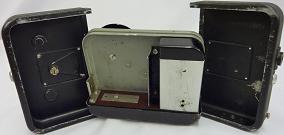
Pict 3; the battery’s compartment
Speeds: The camera speed is only 16 fps. The release button is placed at the front of the camera. The motor run button is fitted with a safety lock mechanism. (Picture 4)
Lens: Eumig Soler; 1: 2,5; F = 12,5; The aperture control is mounted on the lower front panel - from f 2,5 to 22;
Viewfinder: the viewfinder is simple optical with a cross in center of vision.
The camera bottom strap is missing, which connected two fixing points on the body. (Picture 2 - next camera)
Serial production number: 12479
|
|
Pict 2; the footage counter
Pict 4; lens & release button & aperture control
|
|
|
|
|
|
|
|
Eumig Model C4 -1938 Made in Germany
Made by Eumig, Vienna X, Buchengasse 11- 15. On 12 March 1938 Austria was annexed into the German Third Reich. During the WWII on the camera plate was engraved - Made in Germany
The camera features:
Construction and finish: The construction and finish is the same as model manufactured in 1937. Our camera is in very good condition.
Type of loading and transit mechanism: It is slightly different.
The upper and the lower spool spindle have four dogs to engage the take up spool slots.

Pict 1; the film chamber & footage counter arm
Footage counter: the footage counter is deferent from the model produced in 1937. The scale is connected to the swinging arm, which rest on the film on the supply spool. The scale is placed on the right cover and the counter is in meters and foot Pict 1.
Motor and mechanism: The camera uses the electric motor powered by dry cell 3R12; 4,5 Volt.
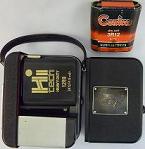
Pict 2; the battery compartment
Speeds: The camera speed is only 16 fps.
Lens: Eumig Soler; 1: 2,5; F = 12,5
Viewfinder: the same as above.
Accessories: the camera is in the original presentation box. It came with the exposure calculator. The camera has the original Guarantee certificate with the production number of the camera.
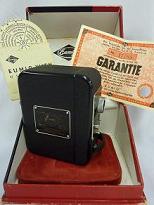
Pict 3; the accessories
Serial production number: 17785
|
|
Pict 4; the logo plate |
|
|
|
|
|
|
|
Eumig Model C3 ca 1953 -Black
Made by Eumig, Vienna X, Austria, Buchengasse 11- 15.
The body of the camera is die-cast and pressed steel lid, with black wrinkle finish. Metal parts chrome plated. The body does not have a model identification.
In the film chamber, the claw mechanism is cover with black plastic preventing the film from dust.
The features:
- Lens: Schneider Kreuznach Xenoplan: 1:1,9, 13 mm; fixed focus; the lens is bloomed; the iris geared to an iris in the exposure-meter cell window, is operated by an extended lever; Lens apertures from f/1.9 to f/16 are marked
- the exposure meter mechanism on front of the camera;
- the light sensitive cell fitted below the lens;
- the motor spring on one winding runs 8 feet of film, which corresponds to a projection period of about 40 seconds;
- the operating button is placed at the back of the camera; the button is tapped to take a cable release for single frame exposures;
- the knob at the camera side can be turned (the middle one in the picture) to: normal running, continuous running or safety lock;
- film counter (left bottom button in the picture) is calibrated in meters - from 0 to 7 1/2 meters. The counter consists two rotating rings: the outer one carries the index mark - it must to be pressed down and turned forward until the red triangular mark is exactly opposite the red dot on the ring surrounding the film counter disc. The inner one is film counter carries a start of film leader and end of trailer mark;
- adjusted speed to: 8, 16 or 32 fps; the bottom right knobs are for setting taking speed and emulsion speed of film in use - the outer knob is engraved with the speeds: 8, 16, 32 and with the letters ( in this model): A, B, C, D, E. The inner knob carries a reference dot for setting either of the letters and the speed is set against a reference dot on the side button;
- the viewfinder has no parallax adjustment, but a line indicates the top of the field at a distance of 2 meters;
- the camera takes standard double 8 film;
- a tripod screw hole, the Continental standard;
- a plastic cap for protection the lens and photocell.
Serial production number: No 46986
Source: “Amateur Cine World” - October 1953 (price: one shilling:)))
In this volume was published - ‘Test report’, on this new camera in the UK.
|
|
|
|
|
|
|
|
|
|
Eumig Model C3 ca 1954 - Green
Made by Eumig, Vienna X, Austria, Buchengasse 11- 15.
The body of the camera is die-cast and pressed steel lid, with green wrinkle finish. Metal parts chrome plated. In the chamber, the claw mechanism is cover with black plastic preventing the film from dust.
Nearly all features are the same as black model described above.
Modifications:
- The knob for setting speed and emulsion speed of film is a little deferent. The inner knob is engraved with the letters: ASA. On the outer knob the black model is showing the film speed in letters, these correspond to following speeds (in brackets the black model):
3 ASA (=A), 6 ASA (=B), 12 ASA (=C), 25 ASA (=D), 50 ASA (=E).
- Another lightly deferent feature is in the film chamber. The claw mechanism is covered with the different shape of plastic cover. On the cover is pressed the camera model - C3. Additionally anti spill lever is fitted between the film spools;
- The model identification is engraved on the plate with camera logo - between the viewfinder and the lens;
- a tripod screw hole, the British standard;
- the production number is engraved beside the tripod hole, when in the black model it is in the film chamber.
Serial production number: No 467698
|
|
|
|
|
|
|
|
|
|
Eumig Model C3 ca 1954 - Green
It is the same model of Eumig C3 as it was described above.
Serial production number: No 463246
|
|
|
|
|
|
|
|
|
|
Eumig Model C3 R 1958 with Turret Head
Made by Eumig, Vienna X, Austria, Buchengasse 11- 15.
The body of the camera is die-cast and pressed steel lid, with gray-green wrinkle finish. Metal parts chrome plated. The body of our camera does not have a model identification, because the plastic part along the left hand side of the turret is broken.
This model has been advertised in 1958-1959 in ‘Amateur Cine World’ by many cine sale companies.
The features:
- Lens:
- Eumig-Wien Eumigon X7234 f/1.9 12,5mm - standard lens
- lens turret:
= Eumig Eumakro 2x No 507306 - for tele attachment, it gives double the size of the image. Focal length 25 mm; for tele shot the mark for 6’6” (2 meters) is shown by little squares in the upper corner of the viewfinder. When using the tele attachment it has to be focus.
The markings on the lens are engraved in yellow color for further supplements to this camera which will be engraved in the corresponding color (right lens in the picture).
= Eumig Eumicron 0,5x No 514671 - for wide angle attachment, the focal length is halved giving a wide field of view; The markings on the lens are engraved in green color (top in the picture).
- Filters - Between the threads for the attachments (between the lenses) there is a black steel spring designed to hold the color filters. When slid in they can be used with the normal lens or can be fitted in front of the tele 2x and wild angle attachments.
- Built in automatically compensated photo-electric exposure meter with the needle visible in the viewfinder window
- The constant speed motor runs 8 feet of film at one winding.
- Speeds 8, 18, 32 fps and single frames; 7, 10, 13, 16, 19 DIN.
- The camera takes 25 ft daylight loading spools of double-run 8mm film.
- The Kodachrome II daylight double 8 mm roll, 25 ft of film is in the case.
The camera is in original case and the short instruction in three languages is supplied.
 |
Serial production number: No 595680
|
|
|
|
|
|
|
|
|
|
Eumig Model C3 M 1960; standard 8 mm
standard 8 mm by Eumig, Vienna X, Austria, Buchengasse 11- 15.
The body of the camera is die-cast and pressed steel lid, as in model C3 with green finish and blue trim.
Many features from model C3 are improved.
Features:
- Turret head fitted with (original plastic lens cup):
- normal Eumigon 1:1,8 F=12,5 mm - prime lens;
- wide angle Eumicron 0,5x F=6,25 mm - converter lens;
- telephoto Eumarco 2,5x F=32,25 mm - converter lens.
All lenses are coated.
- Central focusing wheel operating on all three lenses with “fixed focus” settings for each;
- The model C3M also has a telescopic viewfinder (1:1) with adjustable ocular and push-on moulded eyepiece.
- photoelectric meter, coupled to aperture control - needle visible in viewfinder, adjustable 11 to 21 deg. DIN (10-100 ASA);
- filming speeds of 16, 24 and 32 fps; single frames and continuous run;
- clockwork motor with power reserve indicator. Checking the axes red line position, in the center of the winding key, it is visible the state of the motor power;
 |
- footage indicator with audible warning signal;
- pistol grip with wrist strap and cable release;
- rewind axle with crank.
- illustrated film lacing path in the film chamber. The claw mechanism is covered with the different shape of plastic cover than in model C3 - see in the picture:
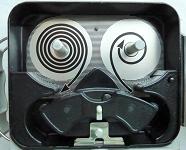 |
- A back wind handle is missing in our collection;
- The camera is in the original Eumig travel box, with the Austria emblem, on the cover.
Serial production number: No 798935 |
|
|
|
|
|
|
|
|
|
Eumig Model C3 M 1960; standard 8 mm
The features are the same as above camera except that with camera came other accessories:
- Parallax compensation - to give absolutely accurate correction of the view finder image;
- Matte box for uses: 1.Lens hood; 2.Filter holder; 3.Matte box; 4.Tiltler

- Back wind handle;
- Instruction book in English language, compendium instruction, filters instruction.
- cleaning tissue for lenses.
Serial production number: No 771688
|
|
|
|
|
|
|
|
|
|
Quartz 2 M - standard double 8 mm 1968
The camera was made in Russia for the Russian market at 16 December 1968
Some descriptions are in Russian language.
The camera body is made from die-cast and pressed still lid. Finished with gray-black hammer paint.
The camera features:
- Lens: Đ® -24M No 6823595; 1,9/12,5;
- Viewfinder: looking through the window of the viewfinder, it is visible the needle of the light meter and a static pointer, which provides a datum line with which the meter needle must be aligned;
- Footage indicator in meters and ft: 7,5 m; 25 ft;
- Filming speed: 8; 12; 16; 24; 32; 48; fps; single frames; run and continuos run;
- Wind angle and telephoto adapter;
- The photoelectric exposure meter built in; the sensitivity of film can be set: 12; 17; 25; 40; 50; 80 and 100 ASA; or in DIN: 11; 16; 22; 32; 45; 65; 90;
- Illustrated film path in the film chamber;
- The spring clockwork motor;
Accessories:
- Back wind handle;
- Ten filters;
- The original leather case;
- Film spool and film 2 x 8 mm in the camera;
- Four films in the metal container;
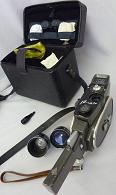 |
No visible production number on the camera body; the date of the production is stamped on a stripe of the paper inside of the camera box.
|
|
|
|
|
|
|
|
|
|
Pathe Auto Camex - Model K 2 - 1965
The camera is unusual in many ways. The camera was produced just one year before super eight appeared in the market. In this way the camera was produced during a very short period.
The camera was sold as: Pathe Imperial; Auto Camex and sold in America as Royal 8.
The camera body is made from die-cast. Finished with light gray-black hammer paint.
This model was designed as a micro electronic model.
The camera features:
- Lens with zoom lever: Angenieux - Zoom Type K2, No 1057401; P. ANGENIEUX Paris F 7.5 - 35 mm; 1:1.8; The camera is fitted with the lens hood. The lens is coated; This model takes lens zoom P. ANGENIEUX F 9 - 36 mm and F 6,5 - 52 mm or zoom Berthiot F 8 - 40 mm.
- eyepiece adjustment as a notched ring at the bottom of rubber eyepiece;
- Spring motor, 8 1/2 ft useful run; At 16 fps this corresponds to a scene of over 40 sec.
- Camera speed 8 -64 fps;
- Film speed depending of the film sensitivity - ASA 12 - 400 or DIN 12 - 28 (Control panel - speed indicator in the left corner) ; single frame exposure ;
- Film rewind (rewind handle - right side);
-Two features are working only with batteries;
- the automatic exposure system is controlled by four long life batteries

- the one battery controlling the fading circuit (placed in the chamber , in small box between the film spools);
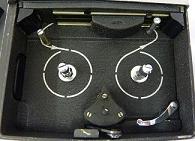
- illustrated film lacing path in the film chamber. The claw mechanism is covered with the plastic guide ( taken out in the picture);
- Self setting footage counter - in the picture Control panel - small red window; automatic indicator if film is in the camera (over footage counter). Film counter - below eyepiece
- Roll-loading 25 ft capacity of double eight film, it runs through the camera twice, once on each side;
- The camera is fitted with jack recorder. A portable transistor tape recorder or AC recorder can be connected to the camera through the cord. when the release button is pushed the recorder and camera automatically start together.
- The camera is fitted with the pistol grip. Our camera does not have cable release, which will eliminate camera motion for single frame filming, and permit extended continuos running;
- Serial production number: 5553
|
|
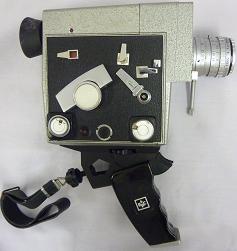
Control panel |
|
|
|
|
|
|
|
(1) (2) (3) (4) (5)
|
|
|
|
|
Page Back
|
|
|
|